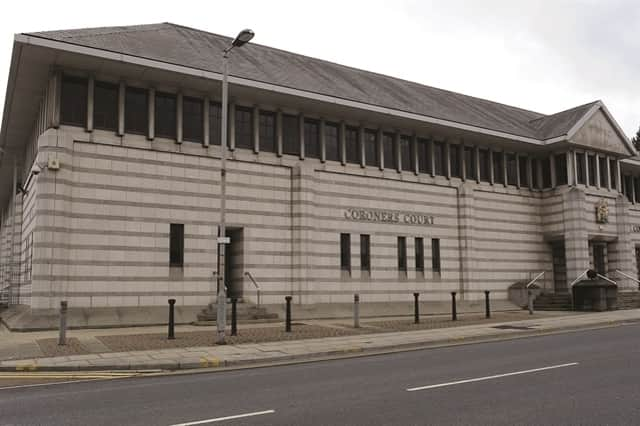Doctors failed to measure spina bifida girl's head for two years, inquest told


Doncaster Coroner’s Court was told Sydney Megson had undergone surgery at just a day old for the condition after being born prematurely.
She was treated by the community paediatric team in Rotherham, Sheffield Children’s Hospital and at her local GP surgery, Brinsworth Medical Centre, during her short life.
Advertisement
Hide AdAdvertisement
Hide AdThe medical cause of death was given as chronic hydrocephalus, of which one symptom can be an enlarged head, with the inquest told the little girl’s head had not been measured for more than two years by any of the services treating her.
Sydney’s death was confirmed at Rotherham Hospital at 7.12am on April 2 last year after was found on her back in bed and not breathing in bed at 6am.
The inquest was told she had not been “feeling herself” the night before and had been off sick from school most of the preceding week.
Between January and April, she had been suffering from a cough at night, after which she often vomited, and she had also snored and breathed noisily.
Advertisement
Hide AdAdvertisement
Hide AdThe inquest heard her mother Anna Megson had tried to perform CPR but realised her daughter was not responding.
An ambulance was called and CPR continued there and at the hospital before Sydney’s death was confirmed.
Pathologist Dr Sophie Stenton gave the medical cause of death as chronic hydrocephalus — too much spinal fluid being produced which leads to excess fluid in and pressure on the brain.
Dr Stenton said hydrocephalus can be caused by conditions such as spina bifida and Ms Megson told the inquest she had been informed shortly after Sydney’s birth the risk of developing hydrocephalus was up to 89 per cent until the age of two when it dropped to 11 per cent.
Advertisement
Hide AdAdvertisement
Hide AdHer daughter, who had a good sense of humour and was “obsessed” with animals and the outdoors, had been developing well and meeting educational milestones.
While she sometimes needed catheterisation and incontinence pads, she would not appear any different to other children despite her health issues.
Consultant neurosurgeon Patricia De-Lacy from Sheffield Children’s Hospital said infants’ heads were measured regularly up until the age of two when they were measured annually.
The court heard Sydney's head was last measured in December 2019 and was 47.9cm in circumference.
Advertisement
Hide AdAdvertisement
Hide AdShe was not measured again by any of the services treating her until the post-mortem, when it was 53cm.
The Assistant Doncaster Coroner, Ms Georgina Gibbs, told the court she had “real concerns about the failure” to do so.
GP Dr Manish Singh said there had been numerous appointments, mainly via telephone, between the surgery and both Ms Megson and her grandmother about coughing and sleeping problems, and an inhaler had been prescribed as various GPs thought it could be asthma or a respiratory condition.
Ms Megson said she had contacted Dr De-Lacy by email in December 2021 about the possibility of hydrocephalus after noting Sydney had a polyp in her nostril but was “reassured” by Dr De-Lacy and Sydney was referred to the ear, nose and throat team.
Advertisement
Hide AdAdvertisement
Hide AdDue to a backlog, the earliest appointment that could be made for her was in May 2022 — a month after she died, and just a month short of her fifth birthday.
Dr De-Lacy told the court had Sydney had her head measured it was likely she would have been sent for a CT scan and if hydrocephalus was suspected it would have likely led to inter-cranial pressure monitoring and potentially shunt surgery.
Dr De-Lacy also asked the coroner to consider whether three viruses common in children and the respiratory infection noted by the pathologist in Sydney may have played a part in her death as, in her view, the infection could have led to increased pressure on the brain.
Ms Gibbs contacted Ms Stenton overnight for clarification and was told it did not cause death but could be considered a contributory factor.
Advertisement
Hide AdAdvertisement
Hide AdSummarising, Ms Gibbs told the court if a head measurement had taken place it would have been a “red flag for hydrocephalus” which would have led to further investigations.
But she said the threshold for neglect was “very, very high” and went on to make no finding of neglect in relation to Sydney’s care.
Cause of death was recorded as chronic hydrocephalus, with the respiratory tract infection a contributory factor. She stressed it was not the cause, adding: “There is simply no dispute about that.”
Ms Gibbs recorded a combination conclusion of a short form of natural causes with a narrative conclusion of: “Sydney Megson was born with spina bifida, which increases the likelihood of hydrocephalus, which condition if left untreated can be fatal, as here.
Advertisement
Hide AdAdvertisement
Hide Ad“There was a missed opportunity over an extended period to detect Sydney Megson’s increasing head circumference.
“Had such basic measurements been performed more regularly, as was required, this would most likely have revealed increasing hydrocephalus and led to inter-cranial pressure monitoring, and subsequent shunt surgery to drain extra fluid and prevent pressure in the brain.”